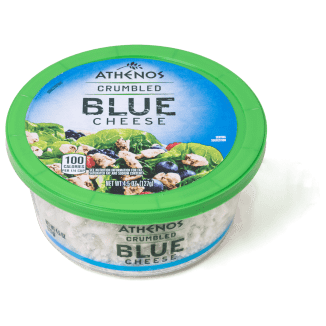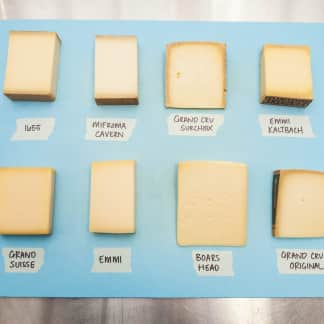Wedges of blue cheese are great for cheese plates, but precrumbled blue cheese, sold in plastic tubs, is a convenient shortcut. It saves you the messy step of breaking up a block by hand, and the crumbles are just the right size for sprinkling over a salad or measuring for dips, dressings, stuffings, sauces, and more.
To find the best crumbled blue cheese, we surveyed the market and chose five top-selling products. We’re not talking about Roquefort, Stilton, and Gorgonzola here, as the majority of crumbled blue cheese sold in the United States is made from cow’s milk, aged for at least 60 days, and known simply as “blue cheese.” A panel of 21 tasters sampled each of the five products in three blind taste tests: plain, in blue cheese dressing, and toasted on crostini. The goal was to find a rich, creamy cheese with a pungent, balanced sharpness or funk.
We noticed right away that tasters preferred cheeses that were bluer in color, finding them “intensely tangy and pungent,” while they compared whiter cheeses to “feta” or “cheddar.” The trend held for dressing, too; those made with whiter cheeses were fine but lacked blue cheese’s signature “blue” flavor and thus tasted more like ranch or mayonnaise. The blue color in blue cheese is mold, so we knew we liked moldier cheeses. To understand why, we took a deeper dive into how blue cheese is made.

First off, bluer blue cheeses are more flavorful because the blue mold produces an enzyme that reacts with the cheese, creating potent flavor compounds called ketones that give the cheese its characteristic flavor. To make blue cheese, mold spores are added to the milk early in the cheese-making process. Like seeds in soil, the mold spores germinate and grow as the cheese ages. We asked cheese-industry experts if our top-ranking cheeses simply had more spores added, but they said no. Mold needs oxygen to grow, and how blue a blue cheese is depends largely on how much oxygen it has been exposed to—more oxygen means more flavorful mold.
Cheese makers can expose the mold spores in the cheese to oxygen in two ways: by creating a more porous cheese that traps air inside or by poking holes in the cheese after it’s formed to ventilate the interior. Some manufacturers exposed their cheeses to more oxygen, and we liked these products more.
Yet while tasters had a clear preference for sharper cheeses, our second-place cheese, from Boar’s Head, was too much for some—it was so funky it practically had a horn section. We recommend it because our tasting panel liked robust blue-cheese flavor, but it might not be for those who prefer a milder flavor profile.

We noticed another quality shared by our top two cheeses: They both use raw milk, while the three lower-ranking cheeses use pasteurized milk. According to cheese expert Dean Sommer, cheese and food technologist at the Center for Dairy Research at the University of Wisconsin–Madison, raw milk cheeses “develop flavor faster, develop more intense flavors, and develop more breadth of flavor than do pasteurized milk cheeses.” This may be another reason why tasters dubbed lower-ranking cheeses made with pasteurized milk “bland” and “mild” but described the top two cheeses, both made with raw milk, as especially “rich” and “flavorful.”
Texture also played into our preferences. One of the challenges of a crumbled cheese is keeping the crumbles from compacting. All but one of the cheeses in our lineup had either potato starch or cellulose added to keep the crumbles separate. The lone product without an anticlumping agent was a wee bit stickier, but it didn’t pose a problem. The cheeses with cellulose were a bit dry and powdery when eaten plain; two of them, the two lowest-ranking cheeses, were dry even when mixed into a creamy dressing. The sole cheese that used potato starch, also our top-ranking product, had moist, separate crumbles. Sommer shared that a recent study at UW–Madison concluded that cellulose was drier and more detectable on the tongue than potato starch, and our results bore that out.
Our top cheese, Roth Buttermilk Blue Crumbles, was quite blue in color and had a pronounced blue cheese flavor, with a bold, balanced funk. It’s made with raw milk and adds potato starch instead of cellulose to keep its crumbles separate while maintaining a “lovely” creamy texture.
- Taste plain
- Taste in blue cheese dressing
- Taste toasted on crostini
- Very blue in color, a sign of oxygen exposure
- Made with raw milk










